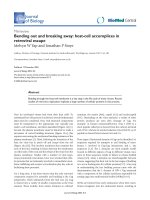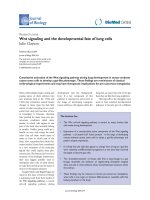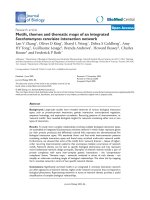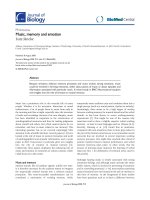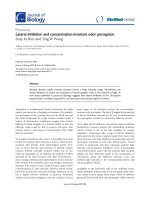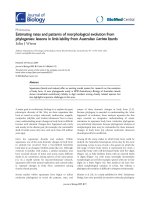Báo cáo sinh học: "Music, memory and emotion" ppt
Bạn đang xem bản rút gọn của tài liệu. Xem và tải ngay bản đầy đủ của tài liệu tại đây (74.03 KB, 5 trang )
Minireview
MMuussiicc,, mmeemmoorryy aanndd eemmoottiioonn
Lutz Jäncke
Address: Department of Neuropsychology, Institute of Psychology, University of Zurich, Binzmuhlestrasse 14, 8050 Zurich, Switzerland.
E-mail:
Music has a prominent role in the everyday life of many
people. Whether it is for recreation, distraction or mood
enhancement, a lot of people listen to music from early in
the morning until late at night, especially since the invention
of radio and recordings. Because of its near ubiquity, music
has been identified as important in the construction of
autobiographical memories and thus for making judgments
about oneself and others. But which musical pieces do we
remember, and how is music related to our memory? This
interesting question has as yet received surprisingly little
attention in the scientific literature. Several papers [1-5] have
looked at the role of music in memory formation and recall
of autobiographical and episodic information, and a recent
paper in BMC Neuroscience in particular gives new insights
into the role of emotion in musical memory [6].
Collectively, these papers emphasize the enhancing role of
music and emotion on memories in various contexts, which
I shall focus on in this review.
MMuussiicc aanndd mmeemmoorryy
Musical sounds, like all auditory signals, unfold over time.
It is therefore necessary for the auditory system to integrate
the sequentially ordered sounds into a coherent musical
perception. This series-to-parallel transformation can be
considered a mechanism of working memory, which
temporarily stores auditory units and combines them into a
single percept (such as a sound pattern, rhythm or melody).
Interestingly, there seems to be a high degree of overlap
between working memory for musical stimuli and for verbal
stimuli, as has been shown in recent working-memory
experiments [7]. This might be one of the reasons why
musicians tend to show a slightly superior verbal working
memory - at least in tonal languages such as Chinese [8,9].
Recently, Sluming et al. [10] found that in musicians,
compared with non-musicians, there is more gray matter in
the part of the frontal cortex known to accommodate neural
networks that are involved in several important working
memory processes. One might thus conclude that a kind of
positive transfer between musical performance and verbal
memory functions takes place; in other words, that the
process of learning music improves the learning of verbal
tasks (see Box 1 for definitions of technical terms used in
this article).
Although hearing music is closely associated with strong
emotional feelings, and although music activates the entire
limbic system, which is involved in processing of emotions
and in controlling memory [11-14], most studies examining
musical memory have not focused on the role of emotion in
this form of memory. In the foreground of these studies
have been questions such as: Is there a difference between
AAbbssttrraacctt
Because emotions enhance memory processes and music evokes strong emotions, music
could be involved in forming memories, either about pieces of music or about episodes and
information associated with particular music. A recent study in
BMC Neuroscience
has given
new insights into the role of emotion in musical memory.
Journal of Biology
2008,
77::
21
Published: 8 August 2008
Journal of Biology
2008,
77::
21 (doi:10.1186/jbiol82)
The electronic version of this article is the complete one and can be
found online at />© 2008 BioMed Central Ltd
implicit (unconscious) and explicit (conscious) musical
memory? Which surface parameters of music, such as
timbre and tempo, are most relevant for efficiently
transferring or encoding musical information into long-
term memory and for retrieving it? Are the titles of musical
pieces recalled better than melodies, for instrumental or for
vocal music?
For example, Halpern and Müllensiefen [1] manipulated
timbre and tempo in order to examine their influence on
implicit and explicit memory for tunes. After encoding 40
unfamiliar short tunes, participants were asked to give
explicit and implicit memory ratings for a list of 80 tunes,
which included 40 that had previously been heard. To
measure implicit memory, a rating of the pleasantness of old
and new melodies was used, whereas to measure explicit
memory the researchers used the difference between the
recognition confidence ratings of old and new melodies.
Half of the 40 previously heard tunes differed in timbre or
tempo in comparison with the first exposure. Change in
timbre and tempo both impaired explicit memory, and
change in tempo also made implicit tune recognition worse.
These findings support the hypothesis on which this experi-
ment was based - that there are two different musical
memory systems, one implicit and the other explicit [1]. A
similar distinction has been drawn by Samson and Peretz
[15]. On the basis of a comprehensive analysis of neuro-
logical patients suffering from lesions in either the right or
the left temporal lobe, they concluded that right temporal
lobe structures have a crucial role in the formation of
melody representations that support priming and memory
recognition, which are both more implicit memory processes,
whereas left-sided temporal lobe structures are more
involved in the explicit retrieval of melodies.
Other studies have focused on one particular aspect of
musical memory, memory for musical pitch. These studies
were motivated by investigations into absolute pitch (or
21.2
Journal of Biology
2008, Volume 7, Article 21 Jäncke />Journal of Biology
2008,
77::
21
BBooxx 11
TTeerrmmss uusseedd iinn mmeemmoorryy rreesseeaarrcchh
•• AArroouussaall
: a state in which bodily resources are mobilized, including the peripheral nervous system, the endocrine
system, and the immune system; a condition of sensory alertness, mobility, and readiness to respond.
•• AAssssoocciiaattiivvee mmeemmoorryy
: a memory system in which a specific piece of memory information is linked to other
memory information by associative links. Recalling a previously experienced item by thinking of something that is
linked with it evokes the association.
•• EEmmoottiioonnaall vvaalleennccee::
the degree of attraction or aversion that an individual feels toward a specific object or event.
•• EEppiissooddiicc mmeemmoorryy::
the memory of events, places, times, associated emotions and other concept-based knowledge
of an experience.
•• SSeemmaannttiicc mmeemmoorryy
: the memory of meanings, understandings and other concept-based knowledge unrelated to
specific experiences.
•• EExxpplliic
ciitt mmeemmoorryy::
conscious memory of facts. Episodic memory and semantic memory are types of declarative
memory, one of the two main divisions of memory along with implicit memory.
•• IImmpplliicciitt mmeemmoorryy::
memory which is not easily verbalized but can be used without consciously thinking about it.
One of the two divisions of memory, along with declarative memory.
•• PPeerrcceeppttuuaall mmeemmoorryy::
changes in the perceptual processing of particular objects or scenes induced by experience.
•• PPoossiittiivvee ttrraannssffeerr::
When learning from one situation supports learning in another.
•• PPrriimmiinngg
: one of the manifestations of implicit memory, in which parts of particular representations or
associations in memory are activated just before carrying out an action or task. Specific cues activate the
perfect pitch), the rare ability of some people to identify or
sing a musical note without relating it to a previously
played note. Many researchers believe that absolute pitch is
a specific kind of musical memory. However, Levitin [2]
found that it was more common than previously assumed.
He asked a large sample of subjects who did not have
absolute pitch to sing popular songs and compared the
produced pitch with the actual pitches used in the recor-
dings of these songs [2]. Approximately 50% of the subjects
sang the song in the correct pitch, at least in one or two
experimental sessions. Forty-four percent were not perfect in
producing the correct pitch but they were within two
semitones of it. Thus, this study shows that even non-
musicians might have relatively stable representations of
pitch [2]. Pitch memory can be improved in non-musicians
by pitch memory training and can even be enhanced by
applying electrical stimulation to the left supramarginal
gyrus [16,17]. Although these studies have told us some
important things about pitch memory, only a few have
focused on memory for longer musical pieces.
MMuussiicc aanndd mmeemmoorriieess ooff aassssoocciiaatteedd eevveennttss
Autobiographical information associated with musical
melodies is evoked when we hear relevant music or when
we are engaged in conversation about music or episodes
and events in our life in which music has been important.
Hearing music associated with our past often evokes a
strong ‘feeling of knowing’. We have this feeling for many
songs without knowing the title or text of the songs. We are,
however, better at recalling the titles of the tunes we listen
to (when the tunes are instrumental) than at remembering a
melody by simply reading or hearing its title. The opposite
pattern occurs when remembering vocals, for which the
titles of the songs are much better cues than the melodies
[3]. The finding of this link between text and music, which
suggests that music is encoded in semantic memory like
text, is of particular importance. Many researchers believe
that music is encoded in the brain by the perceptual
memory system, which organizes auditory information into
melodies and rhythms, rather than by the semantic memory
system, which encodes meaning. Nevertheless, musical
information could be associated with emotional and
semantic information (associative memory), either
indirectly or directly, as was shown [3], even if it is not
directly related to semantic information.
A more recent paper by Stefan Koelsch and colleagues [18]
has elegantly shown that short musical pieces with
particular characteristics can prime the semantic language
memory system, thereby yielding faster and more efficient
recognition of specific words. The general principle of their
experiment [18] was to present target words that were
preceded by either musical or sentence primes. Electrical
brain responses to the target words (the N400 event-related
potential, a dip in scalp electrical activity that occurs 400
milliseconds after the target word) were measured. When
the musical piece was semantically related to the target
word, the brain response to the target word was reduced
(representing less neural activation associated with the
search in semantic memory), whereas when the musical
piece was unrelated to the target word, the response was
enhanced. A typical musical prime for the target word
‘needle’ was a passage of Schönberg‘s String Terzett, which
was written to describe musically the ‘stitching’ pains during
the composer’s heart attack. Other musical primes had been
chosen on the basis of their musicological terminology; for
example, the prime for the word ‘narrowness’ was an
excerpt in which close intervals dominate. Others were
chosen because they resembled the sounds of objects (such
as birds) or qualities of objects (such as low tones
associated with a basement, or ascending steps in pitch with
a staircase) [18]. Taken together, these two experiments
[3,18] demonstrate that there are bidirectional associations
between the memory systems for language and melody.
A specific feature of the perceptually based music memory
system is that the stored information is relatively abstract
(compared with that in semantic memory), allowing
recognition despite changes in instrumentation, loudness,
tempo or register. Lesion studies and recent brain imaging
studies [19-21] have shown that this perceptual memory
system is located bilaterally in the auditory cortex (inclu-
ding the supramarginal gyrus). In addition, the inferior
frontal and inferior temporal brain areas have been shown
to be important in recognizing familiar tunes. To determine
where other kinds of musical memory are stored in the
brain, however, a distinction needs to be made between an
episodic and a semantic musical memory system. Episodic
memory for musical information is defined by Platel and
colleagues [5] as “the capacity to recognize a musical excerpt
(whether familiar or not) for which the spatiotemporal
context surrounding its former encounter (i.e., when, where,
and how) can be recalled”. Semantic memory allows us to
identify familiar songs or melodies by naming the tune or
by humming or whistling the subsequent notes of a
melody. It is thought that musical semantic memory may
represent a musical lexicon, which is different from a verbal
lexicon, even though there are certainly strong links
between them (see above). On the basis of a high-resolu-
tion positron emission tomography study, Platel and
colleagues [5] delineated different brain networks involved
in processing semantic and episodic memory. For episodic
musical memory they found increases in cerebral blood
flow bilaterally in the middle and superior frontal gyrus
region (with a left-sided preponderance) and the precuneus,
/>Journal of Biology
2008, Volume 7, Article 21 Jäncke 21.3
Journal of Biology
2008,
77::
21
whereas for semantic musical memory there was a blood
flow increase bilaterally in the medial and the orbitofrontal
cortex, the left angular gyrus, and the left anterior part of the
middle temporal cortex. From these findings one can
conclude that these two different musical memory systems
have a different neural representation. It is interesting to
note that these brain areas partly overlap with verbal
semantic and episodic memory systems.
EEmmoottiioonn,, mmuussiicc aanndd mmeemmoorryy
Another recent study [22] examined the memories and
emotions that are often evoked when hearing musical
pieces from one’s past. In this experiment, subjects were
presented with a large set of short musical excerpts (not
longer than 30 seconds per excerpt) of past popular songs.
Using a set of newly designed questionnaires, the authors
found that, on average, 30% of the presented songs evoked
autobiographical memories. In addition, most of the songs
also evoked various strong emotions, which were mainly
positive ones such as nostalgia. These results are consistent
with the broader literature (reviewed in [23]) in which
enhanced recall is observed for both positively valenced
(intrinsically pleasant) and arousing (stimulating) events.
Thus, positive emotions and high arousal levels that are
associated with specific events act as a memory enhancer
for these particular events. In the context of associative
memory models, this memory-enhancing effect of emo-
tions and arousal can be explained as a strengthening of
the associations between the memories due to strong
emotions and to arousal.
Until recently however, no study has explicitly examined
whether emotional valence or arousal are correlated with
musical memory. In a recent paper published in BMC
Neuroscience, Eschrich and colleagues [6] investigate
whether musical pieces that induce high arousal and very
positive valence are remembered better by non-musicians
than unarousing and emotionally neutral musical pieces. To
examine these questions the authors designed a behavioral
memory experiment composed of two sessions. In the first
session (the encoding phase) the subjects were exposed to
40 musical pieces, each lasting 20-30 seconds. One week
later, in the recognition phase, participants listened to the
40 old musical excerpts randomly interspersed with 40 new
excerpts and were asked to make a decision about whether
each one was old or new, and to indicate the arousal level
and emotional valence of the pieces. The musical stimuli
were selected from a larger data pool by musically trained
raters and comprised symphonic film music by various
composers. From the old/new decisions of the participating
subjects, the researchers calculated recognition scores and
demonstrated that musical pieces that were rated as very
positive were recognized significantly better than those
rated as less positive. Arousal ratings were not predictive for
recognition performance, meaning that only emotional
valence is related to musical memory [6].
A further part of this experiment [16] was designed to assess
whether different psychological conditions present during
the encoding phase might have an influence on musical
memory performance. For this, the authors divided the
subject sample into two groups: one required to judge
valence during encoding (the emotion group) and the other
required to estimate the length and general loudness of each
musical stimulus (the time-estimation group). The two
groups did not differ in their recognition scores. It is
interesting that the time-estimation group, despite not
concentrating on the emotions during the first encoding
session, showed the same recognition performance as the
emotion group. This shows that emotion is automatically
evoked by the musical pieces and inevitably influences
recognition, even when it is not focused on.
In summary, the study by Eschrich and colleagues [6] is
consistent with the rest of the literature on emotion as a
memory enhancer. The novel aspect of this study, however,
is the finding that musical memory is strongly related to the
rated attractiveness and not to the experienced arousal of
the musical piece. Thus, emotion enhances not only
memories for verbal or pictorial material, as summarized by
Buchanan [23], but also for musical pieces. This study [6]
also provides additional support for a tremendous role of
music in building our autobiographical memories.
Emotional music we have heard at specific periods of our
life is strongly linked to our autobiographical memory and
thus is closely involved in forming our view about our own
self. In this respect it is interesting to note that listening to
music is not only accompanied by blood flow increases in
brain areas known to be involved in generating and
controlling emotions [12,13], but it is also accompanied by
a general increase and change of brain activation within a
distributed network comprising many brain areas and the
peripheral nervous system [11,24-27]. Thus, listening to
music (even when we listen passively) activates many
psychological functions (emotion, memory, attention,
imagery and so on) located in a distributed, overlapping
brain network.
If music has such a strong influence on emotions and our
cognitive system, this raises the question of whether the
memory-enhancing effect of emotional music can be used
to enhance cognitive performance in general and in clinical
settings. In a single-blind, randomized and controlled
study, Särkämö et al. [28] examined whether everyday
music listening can facilitate the recovery of cognitive
21.4
Journal of Biology
2008, Volume 7, Article 21 Jäncke />Journal of Biology
2008,
77::
21
functions and mood after a stroke. The results of this study
revealed that recovery of verbal memory and focused
attention improved significantly in the group of patients
who listened to their favorite music on a daily basis
compared with the patients who listened to audio books or
received no listening material (control group). Besides the
improvement in cognitive functions, there was also a
substantial mood improvement in the patients who listened
to music (they were less depressed and less confused)
compared with the control group.
These studies and especially the study by Eschrich and
colleagues [6] support the tremendous influence of music
on our emotional and cognitive system. Music auto-
matically awakes us, arouses us and engenders specific
emotions in us, which in turn modulates and controls many
cognitive functions.
RReeffeerreenncceess
1. Halpern AR, Müllensiefen D:
EEffffeeccttss ooff ttiimmbbrree aanndd tteemmppoo cchhaannggee
oonn mmeemmoorryy ffoorr mmuussiicc
Q J Exp Psychol (Colchester)
2007, 1.
2. Levitin DJ:
AAbbssoolluuttee mmeemmoorryy ffoorr mmuussiiccaall ppiittcchh:: eevviiddeennccee ffrroomm tthhee
pprroodduuccttiioonn ooff lleeaarrnneedd mmeellooddiieess
Percept Psychophys
1994,
5566::
414-
423.
3. Peynircioglu ZF, Tekcan AI, Wagner JL, Baxter TL, Shaffer SD:
NNaammee oorr hhuumm tthhaatt ttuunnee:: ffeeeelliinngg ooff kknnoowwiinngg ffoorr mmuussiicc
Mem Cognit
1998,
2266::
1131-1137.
4. Platel H:
FFuunnccttiioonnaall nneeuurrooiimmaaggiinngg ooff sseemmaannttiicc aanndd eeppiissooddiicc mmuussiiccaall
mmeemmoorryy
Ann NY Acad Sci
2005,
11006600::
136-147.
5. Platel H, Baron JC, Desgranges B, Bernard F, Eustache F:
SSeemmaannttiicc
aanndd eeppiissooddiicc mmeemmoorryy ooff mmuussiicc aarree ssuubbsseerrvveedd bbyy ddiissttiinncctt nneeuurraall
nneettwwoorrkkss
Neuroimage
2003,
2200::
244-256.
6. Eschrich S, Münte TF, Altenmüller EO:
UUnnffoorrggeettttaabbllee ffiillmm mmuussiicc::
tthhee rroollee ooff eemmoottiioonn iinn eeppiissooddiicc lloonngg tteerrmm mmeemmoorryy ffoorr mmuussiicc
BMC
Neurosci
2008,
99::
48.
7. Schendel ZA, Palmer C:
SSuupppprreessssiioonn eeffffeeccttss oonn mmuussiiccaall aanndd vveerrbbaall
mmeemmoorryy
Mem Cognit
2007,
3355::
640-650.
8. Chan AS, Ho YC, Cheung MC:
MMuussiicc ttrraaiinniinngg iimmpprroovveess vveerrbbaall
mmeemmoorryy
Nature
1998,
339966::
128.
9. Ho YC, Cheung MC, Chan AS:
MMuussiicc ttrraaiinniinngg iimmpprroovveess vveerrbbaall bbuutt
nnoott vviissuuaall mmeemmoorryy:: ccrroossss sseeccttiioonnaall aanndd lloonnggiittuuddiinnaall eexxpplloorraattiioonnss iinn
cchhiillddrreenn
Neuropsychology
2003,
1177::
439-450.
10. Sluming V, Brooks J, Howard M, Downes JJ, Roberts N:
BBrrooccaa’’ss
aarreeaa ssuuppppoorrttss eennhhaanncceedd vviissuuoossppaattiiaall ccooggnniittiioonn iinn oorrcchheessttrraall mmuussii
cciiaannss
J Neurosci
2007,
2277::
3799-3806.
11. Baumgartner T, Esslen M, Jäncke L:
FFrroomm eemmoottiioonn ppeerrcceeppttiioonn ttoo
eemmoottiioonn eexxppeerriieennccee:: eemmoottiioonnss eevvookkeedd bbyy ppiiccttuurreess aanndd ccllaassssiiccaall
mmuussi
icc
Int J Psychophysiol
2006,
6600::
34-43.
12. Baumgartner T, Lutz K, Schmidt CF, Jäncke L:
TThhee eemmoottiioonnaall
ppoowweerr ooff mmuussiicc:: hhooww mmuussiicc eennhhaanncceess tthhee ffeeeelliinngg ooff aaffffeeccttiivvee ppiicc
ttuurreess
Brain Res
2006,
11007755::
151-164.
13. Blood AJ, Zatorre RJ:
IInntteennsseellyy pplleeaassuurraabbllee rreessppoonnsseess ttoo mmuussiicc
ccoorrrreellaattee wwiitthh aaccttiivviittyy iinn bbrraaiinn rreeggiioonnss iimmpplliiccaatteedd iinn rreewwaarrdd aanndd
eemmoottiioonn
Proc Natl Acad Sci USA
2001,
9988::
11818-11823.
14. Blood AJ, Zatorre RJ, Bermudez P, Evans AC:
EEmmoottiioonnaall rreessppoonnsseess
ttoo pplleeaassaanntt aanndd uunnpplleeaassaanntt mmuussiicc ccoorrrreellaattee wwiitthh aaccttiivviittyy iinn ppaarraalliimm
bbiicc
bbrraaiinn rreeggiioonnss
Nat Neurosci
1999,
22::
382-387.
15. Samson S, Peretz I:
EEffffeeccttss ooff pprriioorr eexxppoossuurree oonn mmuussiicc lliikkiinngg aanndd
rreeccooggnniittiioonn iinn ppaattiieennttss wwiitthh tteemmppoorraall lloobbee lleessiioonnss
Ann NY Acad
Sci
2005,
11006600::
419-428.
16. Gaab N, Gaser C, Schlaug G:
IImmpprroovveemmeenntt rreellaatteedd ffuunnccttiioonnaall ppllaass
ttiicciittyy ffoolllloowwiinngg ppiittcchh mmeemmoorryy ttrraaiinniinngg
Neuroimage
2006,
3311::
255-
263.
17. Vines BW, Schnider NM, Schlaug G:
TTeessttiinngg ffoorr ccaauussaalliittyy wwiitthh
ttrraannssccrraanniiaall ddiirreecctt ccuurrrreenntt ssttiimmuullaattiioonn:: ppiittcchh mmeemmoorryy aanndd tthhee lleef
ftt
ssuupprraammaarrggiinnaall ggyyrruuss
Neuroreport
2006,
1177::
1047-1050.
18. Koelsch S, Kasper E, Sammler D, Schulze K, Gunter T, Friederici
AD:
MMuussiicc,, llaanngguuaaggee aanndd mmeeaanniinngg:: bbrraaiinn ssiiggnnaattuurreess ooff sseemmaannttiicc
pprroocceessssiinngg
Nat Neurosci
2004,
77::
302-307.
19. Kohlmetz C, Müller SV, Nager W, Münte TF, Altenmüller E:
SSeelleecc
ttiivvee lloossss ooff ttiimmbbrree ppeerrcceeppttiioonn ffoorr kkeeyybbooaarrdd aanndd ppeerrccuussssiioonn iinnssttrruu
mmeennttss ffoolllloowwiinngg aa rriigghhtt tteemmppoorraall lleessiioonn
Neurocase
2003,
99::
86-93.
20. Peretz I, Coltheart M:
MMoodduullaarriittyy ooff mmuussiicc pprroocceessssiinngg
Nat Neu-
rosci
2003,
66::
688-691.
21. Zatorre RJ, Belin P, Penhune VB:
SSttrruuccttuurree aanndd ffuunnccttiioonn ooff aauuddii
ttoorryy ccoorrtteexx:: mmuussiicc aanndd ssppeeeecchh
Trends Cogn Sci
2002,
66::
37-46.
22. Janata P, Tomic ST, Rakowski SK:
CChhaarraacctteerriizzaattiioonn ooff mmuussiicc
eevvookkeedd aauuttoobbiiooggrraapphhiiccaall mmeemmoorriieess
Memory
2007,
1155::
845-860.
23. Buchanan TW:
RReettrriieevvaall ooff eemmoottiioonnaall mmeemmoorriieess
Psychol Bull
2007,
113333::
761-779.
24. Baumgartner T, Willi M, Jäncke L:
MMoodduullaattiioonn ooff ccoorrttiiccoossppiinnaall
aaccttiivviittyy bbyy ssttrroonngg eemmoottiioonnss eevvookkeedd bbyy ppiiccttuurreess aanndd ccllaassssiiccaall mmuussiicc::
aa ttrraannssccrraanniiaall mmaaggnneettiicc ssttiimmuullaattiioonn ssttuuddyy
Neuroreport
2007,
1188::
261-265.
25. Jefferies LN, Smilek D, Eich E, Enns JT:
EEmmoottiioonnaall vvaalleennccee aanndd
aarroouussaall iinntteerraacctt iinn aatttteennttiioonnaall ccoonnttrrooll
Psychol Sci
2008,
1199::
290-
295.
26. Mizuno T, Sugishita M:
NNeeuurraall ccoorrrreellaatteess uunnddeerrllyyiinngg ppeerrcceeppttiioonn ooff
ttoonnaalliittyy rreellaatteedd eemmoottiioonnaall ccoonntteennttss
Neuroreport
2007,
1188::
1651-
1655.
27. Suda M, Morimoto K, Obata A, Koizumi H, Maki A:
EEmmoottiioonnaall
rreessppoonnsseess ttoo mmuussiicc:: ttoowwaarrddss sscciieennttiiffiicc ppeerrssppeeccttiivveess oonn mmuussiicc
tthheerraappyy
Neuroreport
2008,
1199::
75-78.
28. Särkämö T, Tervaniemi M, Laitinen S, Forsblom A, Soinila S,
Mikkonen M, Autti T, Silvennoinen HM, Erkkilä J, Laine M, Peretz I,
Hietanen M:
MMuussiicc lliisstteenniinngg eennhhaanncceess ccooggnniittiivvee rreeccoovveerryy aanndd
mmoooodd aafftteerr mmiiddddllee cceerreebbrraall aarrtteerryy ssttrrookkee
Brain
2008,
113311::
866-
876.
/>Journal of Biology
2008, Volume 7, Article 21 Jäncke 21.5
Journal of Biology
2008,
77::
21


